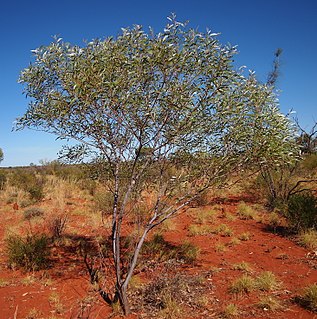
Acacia kempeana, commonly known as wanderrie wattle, witchetty bush or granite wattle, is a shrub in subfamily Mimosoideae of family Fabaceae that is endemic to arid parts of central and western Australia.

Acacia colei is a perennial bush or tree native to northern Australia and southern Asia. A common name for it is Cole's wattle. Acacia colei blooms from May through September and the flowers are bright yellow.

Acacia enterocarpa, commonly known as jumping jack wattle, is a shrub species that is endemic to eastern Australia.

Acacia neriifolia, also known as the oleander wattle, silver wattle or pechy wattle, is a tree in the genus Acacia native to north eastern Australia. It is common in the Moonbi Ranges.
Acacia epedunculata is a shrub belonging to the genus Acacia and the subgenus Juliflorae that is endemic to a very small area in arid parts of western Australia.

Acacia fauntleroyi is a shrub or small tree belonging to the genus Acacia and the subgenus Juliflorae that is endemic to a part of south western Australia.

Acacia hamersleyensis, also known as Karijini wattle or Hamersley Range wattle, is a tree or shrub belonging to the genus Acacia and the subgenus Juliflorae. It is endemic to a small area in central Western Australia.

Acacia mulganeura, commonly known as milky mulga and hilltop mulga, is a tree or shrub belonging to the genus Acacia and the subgenus Juliflorae that is endemic to arid parts of central and western Australia.

Acacia multispicata, commonly known as spiked wattle, is a shrub belonging to the genus Acacia and the subgenus Juliflorae that is endemic to south western Australia.

Acacia pellita is a shrub or tree belonging to the genus Acacia and the subgenus Juliflorae that is endemic to parts of tropical northern Australia.

Acacia thomsonii, commonly known as Thomson's wattle, is a shrub or tree belonging to the genus Acacia and the subgenus Juliflorae that native to parts of northern Australia.

Acacia tysonii, commonly known as Tyson's wattle, is a shrub or tree of the genus Acacia and the subgenus Phyllodineae that is endemic to parts of western Australia.

Acacia costiniana, commonly known as Costin's wattle, is a shrub belonging to the genus Acacia and the subgenus Phyllodineae that is endemic to eastern Australia.

Acacia polifolia is a shrub belonging to the genus Acacia and the subgenus Phyllodineae that is native to parts of eastern Australia.

Acacia kybeanensis, commonly known as kybean wattle or kybeyan wattle, is a shrub of the genus Acacia and the subgenus Phyllodineae that is endemic to south eastern Australia.

Acacia curranii, also known as curly-bark wattle, is a shrub belonging to the genus Acacia and the subgenus Juliflorae that is native to north eastern Australia. It is listed as vulnerable under the Environment Protection and Biodiversity Conservation Act 1999.

Acacia leptostachya, commonly known as Townsville wattle or slender wattle, is a shrub or small tree belonging to the genus Acacia and the subgenus Juliflorae that is native to north eastern Australia.

Acacia mariae, commonly known as golden-top wattle or crowned wattle, is a species of wattle native to central New South Wales.

Acacia sericoflorais a shrub or tree belonging to the genus Acacia and the subgenus Juliflorae that is native to northern Australia.

Acacia tarculensis, commonly known as granite wattle, granite bush or steel bush is a shrub belonging to the genus Acacia and the subgenus Juliflorae that is native to south central Australia.




















